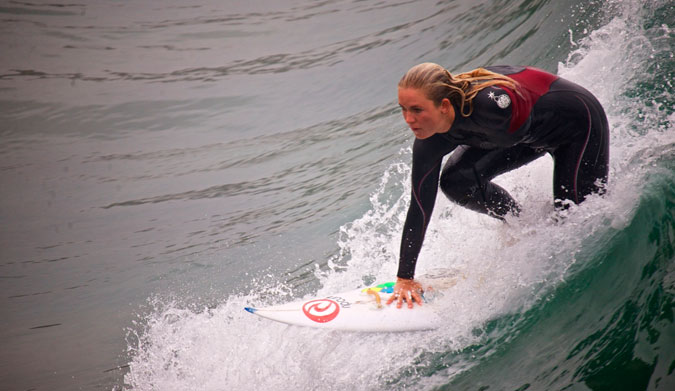
The pop up is one of the most important parts of surfing. If you don’t have it mastered, the rest will be that much harder. Photo: Shutterstock
Surfing requires the mastery of a few fundamentals:
1. Paddling to seek out and catch waves
2. Getting to your feet, and then
3. Be awesome, or at least have so much fun that you don’t care, which is just as awesome as being awesome.
Statistically, you spend more time in the water paddling than anything else, so your cost/benefit ratio in terms of time spent training/surfing outcome is no doubt spent here. According to an article by Stu Nettle, paddling takes up as much as 43% of your time, which is divided between paddling to the lineup (39%), and sprinting your butt off to catch waves (4%).
But if you can’t get to your feet quickly, then both paddling for that wave and hoping to be gnarly once you have it are somewhat moot. This is probably why I personally spend so much time answering questions from established and learner surfers about this topic.
I have previously written about strength training progressions for the pop up here, and have received a number of requests from you guys to revisit it. So the purpose of this article is to see if I could explain this ancient Hawaiian art form with a modern strength and conditioning spin.
Why you need to know about the “Stretch to Shorten Cycle”
If you are transitioning from a longboard to a shortboard, all of a sudden you are faced with your greatest pop up challenge. You can’t cheat by using your back leg anymore, and you have to learn to bounce. You need more “pop” in your pop up.
In my opinion, you will gain your greatest efficiency in doing so my making the most of a concept known in strength and conditioning circles as the “Stretch to Shorten Cycle (SSC).” Think of the SSC as elastic potential: If you wind up both ends of a rubber band, then let one end go, it will snap forward.
Although we don’t exactly know, we think this occurs to a degree through the elongation of your muscular and connective tissues, particularly the tendons. An article by Anthony Turner and Ian Jeffreys in the Journal of Strength and Conditioning agrees with this assumption, and further prescribes the use of plyometric principles to help reinforce this, once “ensuring the athlete is technically competent in each stage before progressing in intensity and complexity.”
The good news is that you already know how to do this without needing a strength and conditioning lab to prove it. You probably instinctively know that if you want to throw a ball, you have to pull your arm back first, or you risk throwing like a muppet. If you want to jump as high as possible you first bounce into it, and that you can do more pull ups if you bounce off the bottom compared to a dead hang.
It comes pretty naturally, and works within the limits of what your body allows. If the health and function of your spring is crap, so is your elastic potential, but is totally retrainable.
In the pop up, you will gain the greatest effect by focusing on the SSC as it relates to your trunk and hip flexor chain. You know these as your abs, and your hip flexors or quads.
Winding up your spring

If you think of your abs and hip flexors as elastic, then stretching it at both ends acts like a spring
As the waves catches you, extending your upper body puts your anterior flexor chain of abdominals and hip flexors into a full range of motion stretch. This weight transfer winds up your hip flexors as you bounce your thighs and knees off your tailpad to then spring them forward. Simultaneously, you will be stretching your upper abs and then rapidly shortening them to the same effect.

Once you transfer your weight to “bounce” off your knees, this allows your hips to flex rapidly, now be epic.
Essential “spring” care and maintenance
Your spring might not work very well. This will happen if your muscle and connective tissue can’t extend because it’s too jammed up, OR if it’s just too weak.
Commonly I find this means that people have upper abs that are way to rigid, and hip flexors commonly either so stretched or bound up that they have lost much elasticity.
So if your spring is buggered, you may need to rebuild it. This is what Turner and Jeffreys argue prior to simply using plyometric training, which is the ideal method for being “springy”.
In this video, I offer you a method for doing so:
Repetition is the mother of skill. If you have a spring that works perfectly, then I encourage you to start practicing your pop up with this analogy in mind, especially if you are currently slow at getting to your feet.
You can do this through consistent practice. A good pop is done with explosive speed, and this energy system typically diminishes after a few seconds, so I don’t recommend doing sets of more than 4-6 reps, but could even be fewer. So why not simply practice one or two, every so often?
If your spring isn’t so good, then I offer you a method for starting your process of improving it in this video, and also with my “Perfecting the Popup” online program.
See more from Ash at Weekend Surf Warrior

